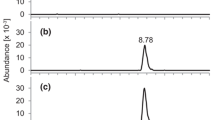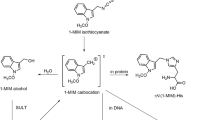Abstract
Ethylene oxide (EO), a genotoxic industrial chemical and sterilant, forms covalent adducts with DNA and also with nucleophilic amino acids in proteins. The adduct with N-terminal valine in globin [N-(2-hydroxyethyl)valine (HEV)] has been used in biomonitoring of cumulative exposures to EO. Here we studied in rats the fate of EO-adducted N-termini of globin after life termination of the erythrocytes. Rat erythrocytes were incubated with EO to produce the HEV levels in globin at 0.4–13.2 µmol/g as determined after acidic hydrolysis. Alternative hydrolysis of the isolated globin with enzyme pronase afforded N-(2-hydroxyethyl)-l-valyl-l-leucine (HEVL) and N-(2-hydroxyethyl)-l-valyl-l-histidine (HEVH), the EO-adducted N-terminal dipeptides of rat globin α- and β-chains, respectively. The ratio of HEVL/HEVH (1:3) reflected higher reactivity of EO with the β-chain. The EO-modified erythrocytes were then given intravenously to the recipient rats. HEVL and HEVH were found to be the ultimate cleavage products excreted in the rat urine. Finally, rats were dosed intraperitoneally with EO, 50 mg/kg. Herein, the initial level of globin-bound HEVL (11.7 ± 1.3 nmol/g) decreased almost linearly over 60 days corresponding to the life span of rat erythrocytes. Daily urinary excretion of HEVL was almost constant for 30–40 days, decreasing faster in the subsequent phase of elimination. Recoveries of the total urinary HEVL from its globin-bound form were 84 ± 6% and 101 ± 17% after administrations of EO and the EO-modified erythrocytes, respectively. In conclusion, urinary HEVL appears to be a promising novel non-invasive biomarker of human exposures to EO.





Similar content being viewed by others
References
Altman PL, Dittmer DS (eds) (1974) Biology data book, vol III. Federation of American Societies for Experimental Biology, p 1847
Bader M, Lewalter J, Angerer J (1995) Analysis of N-alkylated amino acids in human hemoglobin: evidence for elevated N-methylvaline levels in smokers. Int Arch Occup Environ Health 67(4):237–242
Bailey E, Brooks AGF, Dollery CT, Farmer PB, Passingham BJ, Sleightholm MA, Yates DW (1988) Hydroxyethylvaline adduct formation in haemoglobin as a biological monitor of cigarette smoke intake. Arch Toxicol 62(4):247–253
Basile A, Ferranti P, Pocsfalvi G, Mamone G, Miraglia N, Caira S, Ambrosi L, Soleo L, Sannolo N, Malorni A (2001) A novel approach for identification and measurement of hemoglobin adducts with 1,2,3,4-diepoxybutane by liquid chromatography/electrospray ionisation mass spectrometry and matrix-assisted laser desorption/ionisation tandem mass spectrometry. Rapid Commun Mass Spectrom 15(8):527–540
Basile A, Ferranti P, Mamone G, Manco I, Pocsfalvi G, Malorni A, Acampora A, Sannolo N (2002) Structural analysis of styrene oxide/haemoglobin adducts by mass spectrometry: identification of suitable biomarkers for human exposure evaluation. Rapid Commun Mass Spectrom 16(9):871–878
Boogaard P (2002) Use of haemoglobin adducts in exposure monitoring and risk assessment (review). J Chromatogr B 778(1–2):309–322
Calleman CJ, Ehrenberg L, Jansson B, Osterman-Golkar S, Segerbäck D, Svensson K, Wachtmeister CA (1978) Monitoring and risk assessment by means of alkyl groups in hemoglobin in persons occupationally exposed to ethylene oxide. J Environ Pathol Toxicol 2(2):427–442
DFG-Deutsche Forschungsgemeinschaft (1991) Analyses of hazardous substances in air, vol 3. Wiley, Hoboken, pp 55–63
DFG-Deutsche Forschungsgemeinschaft (1997) Analyses of hazardous substances in biological materials, vol 5. Wiley, Hoboken, pp 181–210
Ehrenberg L, Osterman-Golkar S, Segerbäck D, Svensson K, Calleman CJ (1977) Evaluation of genetic risks of alkylating agents. III. Alkylation of haemoglobin after metabolic conversion of ethene to ethene oxide in vivo. Mutat Res 45(2):175–184
Farmer PB (1999) Studies using specific biomarkers for human exposure assessment to exogenous and endogenous chemical agents. Mutat Res 428(1–2):69–81
Farmer PB, Bailey E, Gorf SM, Törnqvist M, Osterman-Golkar S, Kautiainen A, Lewis-Enright DP (1986) Monitoring human exposure to ethylene oxide by the determination of haemoglobin adducts using gas chromatography–mass spectrometry. Carcinogenesis 7(4):637–640
Fennell TR, Sumner SCJ, Walker VE (1992) A model for the formation and removal of hemoglobin adducts. Cancer Epidemiol Biomark Prev 1(3):213–219
Haufroid V, Merz B, Hofmann A, Tschopp A, Lison D, Hotz P (2007) Exposure to ethylene oxide in hospitals: biological monitoring and influence of glutathione S-transferase and epoxide hydrolase polymorphism. Cancer Epidemiol Biomark Prev 16(4):796–802
Homolka J (1971) Clinical examination methods, 2nd edn., p 96, Avicenum, Praha (in Czech)
IARC - International Agency for Research on Cancer (2008) 1,3-butadiene, ethylene oxide and vinyl halides, IARC monographs on the evaluation of carcinogenic risks to humans, vol 97. World Health Organization, Geneva
Jones AR, Wells G (1981) The comparative metabolism of 2-bromoethanol and ethylene-oxide in the rat. Xenobiotica 11(11):763–770
Lauwerys RR, Hoet P (2001) Industrial chemical exposure. Guidelines for biological monitoring, 3rd edn. Lewis Publishers, Boca Raton (ISBN 1-56670-545-2)
Mráz J, Hanzlíková I, Moulisová A, Dušková Š, Hejl K, Bednářová A, Linhart I (2016a) Hydrolytic cleavage products of globin adducts in urine as possible biomarkers of cumulative dose. Proof of concept using styrene oxide as a model adduct-forming compound. Chem Res Toxicol 29(4):676–686
Mráz J, Hanzlíková I, Dušková Š, Dabrowská L, Chrástecká H, Vajtrová R, Linhart I (2016b) Biological fate of styrene oxide adducts with globin: elimination of cleavage products in the rat urine. Toxicol Lett 261:26–31
Mráz J, Hanzlíková I, Dušková Š, Tvrdíková M, Chrástecká H, Vajtrová R, Linhart I (2018) Determination of N-(2-hydroxyethyl)valine in globin of ethylene oxide-exposed workers using total acidic hydrolysis and HPLC-ESI-MS2. Toxicol Lett 298:76–80
OSHA-Occupational Safety and Health Administration (2014) Method no. 1010 ethylene oxide. https://www.osha.gov/dts/sltc/methods/mdt/mdt1010/1010.html
Osterman-Golkar S, Ehrenberg L, Segerbäck D, Hällström I (1976) Evaluation of genetic risks of alkylating agents. II. Haemoglobin as a dose monitor. Mutat Res 34(1):1–10
Pessoa JC, Calhorda MJ, Cavaco I, Costa PJ, Correia I, Costa D, Vilas-Boas LF, Félix V, Gillard RD, Henriques RT, Wiggins R (2004) N-salicylideneamino acidato complexes of oxovanadium (IV). The cysteine and penicillamine complexes. J Chem Soc Dalton Trans 18:2855–2866
Popp W, Vahrenholz C, Przygoda H et al (1994) DNA-protein cross-links and sister chromatid exchange frequencies in lymphocytes and hydroxyethyl mercapturic acid in urine of ethylene oxide-exposed hospital workers. Int Arch Occup Environ Health 66(5):325–332
Scheick C, Spiteller G, Dasenbrock C (1997) Thiodiacetic acid - a metabolite of ethylene oxide. Z Naturforsch 52(1–2):70–76
Segerbäck D (1983) Alkylation of DNA and hemoglobin in the mouse following exposure to ethene and ethene oxide. Chem Biol Interact 45(2):139–151
Tardif R, Goyal R, Brodeur J, Gérin M (1987) Species differences in the urinary disposition of some metabolites of ethylene oxide. Fundam Appl Toxicol 9(3):448–453
Törnqvist M, Mowrer J, Jensen S, Ehrenberg L (1986) Monitoring of environmental cancer initiators through hemoglobin adducts by a modified Edman degradation method. Anal Biochem 154(1):255–266
Törnqvist M, Magnusson AL, Farmer PB, Tang YS, Jeffrey AM, Wazneh L, Beulink GD, van-der-Waal H, van Sittert NJ (1992) Ring test for low levels of N-2-hydroxyethylvaline in human hemoglobin. Anal Biochem 203(2):357–360
Törnqvist M, Fred C, Haglund J, Helleberg H, Paulsson B, Rydberg P (2002) Protein adducts: quantitative and qualitative aspects of their formation, analysis and applications. J Chromatogr B 778(1–2):279–308
Walker VE, MacNeela JP, Swenberg JA, Turner MJ Jr, Fennell TR (1992) Molecular dosimetry of ethylene oxide: formation and persistence of N-(2-hydroxyethyl)valine in hemoglobin following repeated exposures of rats and mice. Cancer Res 52(16):4320–4327
Wolfs P, Dutrieux M, Scailteur V, Haxhe JJ, Zumofen M, Lauwerys R (1983) Monitoring of workers exposed to ethylene oxide in a plant distributing sterilizing gases and in units for sterilizing medical equipment. Arch Mal Prof 44(3):321–328 (in French)
Wu KY, Chiang SY, Huang TH, Tseng YS, Chen YL, Kuo HW, Hsieh CL (2004) Formation of N-(2-hydroxyethyl)valine in human hemoglobin—effect of lifestyle factors. Mutat Res 559(1–2):73–82
Zhang F, Brzak KA, Pottenger LH, Bartels MJ (2012) Direct quantitation of hydroxyethylvaline in hemoglobin by liquid chromatography/positive electrospray tandem mass spectrometry. J Chromatogr A 1248:84–92
Acknowledgements
The study was supported by the Grant NT13401-4/2012 from Internal Grant Agency of the Czech Ministry of Health, and by the Czech Ministry of Health, Program DRO (National Institute of Public Health—NIPH, IN 75010330). Purchase of the principal analytical instrument, Orbitrap Q Exactive mass spectrometer, was supported by European Regional Development Fund (ERDF), Integrated Operational Programme Reg. No. CZ.1.06/3.2.01/11.08435. Skilled technical assistance of Hana Chrástecká, Monika Tvrdíková, and Radka Vajtrová (all from NIPH) is gratefully acknowledged.
Author information
Authors and Affiliations
Corresponding author
Ethics declarations
Research involving human and/or animal participants
All applicable international, national, and/or institutional guidelines for the care and use of animals were followed. The experiments were approved by the Committee for Animal Protection of the Czech Ministry of Health.
Human data
The manuscript does not contain clinical studies or patient data.
Conflict of interest
The authors declare that they have no conflict of interest.
Additional information
Publisher’s Note
Springer Nature remains neutral with regard to jurisdictional claims in published maps and institutional affiliations.
Rights and permissions
About this article
Cite this article
Mráz, J., Hanzlíková, I., Linhart, I. et al. N-(2-Hydroxyethyl)-l-valyl-l-leucine in rat urine as a hydrolytic cleavage product of ethylene oxide adduct with globin. Arch Toxicol 93, 603–613 (2019). https://doi.org/10.1007/s00204-019-02388-8
Received:
Accepted:
Published:
Issue Date:
DOI: https://doi.org/10.1007/s00204-019-02388-8




